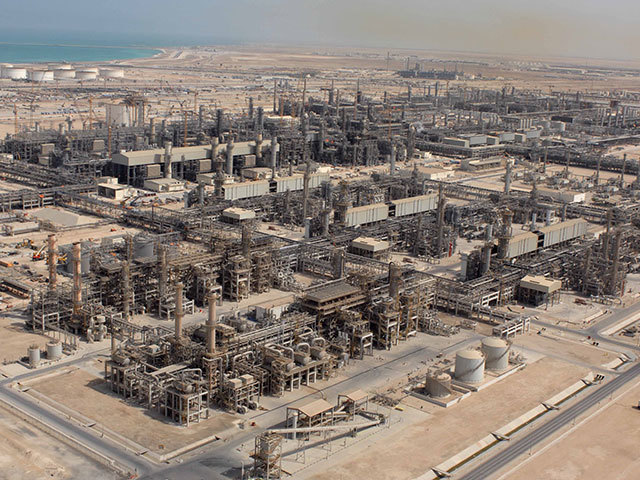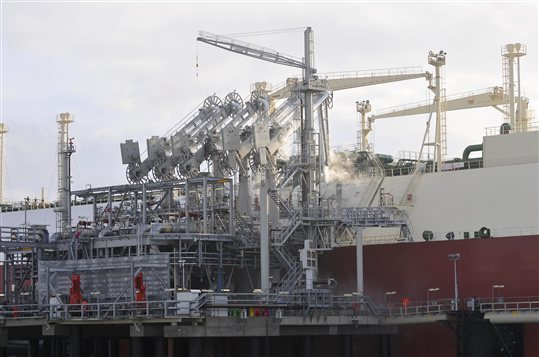
Faced with slumping demand for liquefied natural gas in Asian markets, Qatar is shipping cargoes to Britain, deepening the biggest seasonal price drop for the fuel there in five years.
Qatar, the biggest producer, will send at least eight cargoes to the UK this month, taking the total since April to 35, six more than last year. Prices on the UK’s National Balancing Point, the largest trading hub outside the US, have fallen 25% since the summer started on April 1.
The cargoes, typically big enough to meet about 75% of Britain’s daily gas use, are entering a market where the mildest European winter in seven years damped prices and demand, reducing the need to replenish inventories. Buyers in Asia, the largest LNG market, have covered their summer needs and spare deliveries are heading to Europe, where enough gas is traded to absorb the fuel not required elsewhere, according to Laurent Maurel, a vice president for strategy at Total SA in Paris.
“Producers have got surplus volumes in the summer that they now have to dispose of,” Niall Trimble, managing director at The Energy Contract Co., a London-based consultant whose clients include GDF Suez SA and Korea Gas Corp., said by phone on July 10. “There aren’t that many open markets around the world which have LNG import terminals.”
UK gas for next-month delivery, a European benchmark, rose 3.4% to 38.25 pence a therm ($6.55 a million British thermal units) on London’s ICE Futures Europe exchange at 10.28am, down from 51.27 pence at the close on March 31 and 65.39 pence a year ago.
Asian prices have averaged 75% more than those in the UK this year as buyers in the region sought to offset halted nuclear power generation. LNG cargoes for northeast Asia dropped 42% to $10.65 a million Btu in the period, according to assessments by World Gas Intelligence of prices for delivery in four to eight weeks.
“You had headwinds for prices in both regions,” Michael Widmer, a commodities analyst at Bank of America Corp. in London, said by telephone July 4. “Some of the volumes that could have gone theoretically to the Asian market instead are being moved over to Europe.”
Asian LNG declined as the first shipments from Exxon Mobil Corp.’s Papua New Guinea liquefaction plant boosted supply to the region and demand slowed from utilities in Japan, the biggest buyer of the fuel. Japanese imports from Qatar fell 26% from a year earlier to 188,485 tons in May, according to Finance Ministry data. The nation used about 6% less LNG than it bought for power generation last month, according to the Federation of Electric Power Companies of Japan.
South Korea’s LNG imports from Qatar fell 31% in June from a year earlier as total deliveries dropped 20% on below-normal temperatures, Energy Aspects Ltd. said yesterday in an e-mailed report. The outlook for summer imports remains bearish as cooler-than-usual weather is forecast for the next two weeks, it said.
Asian gas demand, which is typically higher in the northern hemisphere winter, may be bolstered as “very limited numbers” of Japanese nuclear power plants resume operations by the end of the year, Chikako Ishiguro, a senior analyst at Osaka Gas Co., said by e-mail on July 3.
Japan is preparing to restart at least two of 48 nuclear reactors shut in the wake of an earthquake and tsunami that hit the country in March 2011. Kyushu Electric Power Co.’s No. 1 and No. 2 reactors at the Sendai facility in southern Japan passed initial safety checks, the Nuclear Regulation Authority said in a draft report yesterday.
“Northeast Asia and South America will continue to outbid Europe for LNG cargoes for the balance of 2014,” Pan EurAsian Enterprises, a Raleigh, North Carolina-based tracker of LNG shipments, said in a report on July 9.
Qatar has 14 liquefaction plants, known as trains, at least three of which were intended to supply the US, where demand for the fuel waned as booming shale gas output outstripped domestic demand. The Persian Gulf state hasn’t supplied any gas to the US since Feb. 2013, according to Energy Information Administration data through April this year.
In the UK, daily flows from the Qatari-controlled South Hook import terminal, one of four such facilities in the nation, have averaged 41.4 million cubic meters (1.5 billion cubic feet) from April through yesterday, compared with 36.7 million a year earlier, according to National Grid Plc.
With milder weather forecast in northeast Asia in the third quarter, more cargoes might be heading to Europe, Energy Aspects said in a report July 15.
Citigroup Inc. cut its forecast for NBP gas this year by 14% to 48.2 pence a therm “as lower prices are needed to absorb the excess gas supply while imports of LNG into the UK remain robust,” according to the bank’s July 2014 Commodities Strategy report.
In Asia, winter prices may fall below last year’s levels for the season, based on Rim Intelligence Co.’s six-month rolling assessment through March, Pan EurAsian said on July 15.
Changes in shipping destination to Europe from Asia would have a negligible effect on freight rates because the distances from Qatar to east Asia or Europe are similar, according to Keith Bainbridge, managing director of consultant CS LNG in London.
“Qatar produces, nobody else wants it so it comes to Europe,” he said by phone on July 10.
More than 90% of the cargoes arrive at the Qatar Petroleum-controlled South Hook terminal. The ability of UK facilities to receive the largest Qatari tankers, known as Q- Flexes and Q-Maxes, also makes Britain an attractive market, Trimble said.
The Shagra, one of 14 Q-maxes in a global LNG fleet of almost 400 tankers, is due to arrive at South Hook on July 19, according to the Milford Haven Port Authority. The 345-meter (1,133-foot) vessel can carry 261,988 cubic meters of LNG, or about 157 million cubic meters of natural gas. That compares with average UK demand of 195 million so far this summer.
The Al Khattiya tanker arrived yesterday, making its first voyage to the UK since February 2012, ship-tracking data on Bloomberg show.
“You’ve got NBP liquidity, which is probably the primary reason, plus easy or easier access to that market because you have three major terminals,” Richard Sarsfield-Hall, a senior principal at Oxford, England-based Poeyry Consulting, said by phone on June 30. “NBP access makes it an attractive option for where that gas can be sold when it’s not required in the Far East.”
Recommended for you
